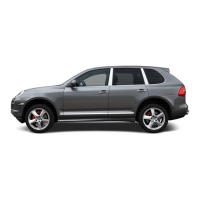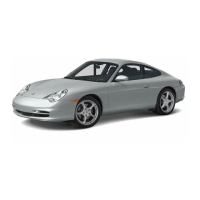Do you have a question about the Porsche 2006 Cayman and is the answer not in the manual?
Details on tire pressure for 18 and 19 inch wheels for summer and snow tires.
Porsche's commitment to environmental protection and safety technology.
Porsche's reliance on environmentally friendly technology in vehicle production.
Essential checks to perform before starting the vehicle.
Adjustments and checks to perform while in the driver's seat.
Safe driving practices and rules to follow while driving.
Tips for optimal performance and initial break-in period.
Explanation of the vehicle's immobilizer system and its function.
Information on securing wheels with special bolts.
Instructions for unlocking the vehicle using the remote control.
Instructions for locking the vehicle using the remote control.
Troubleshooting steps for remote control malfunctions.
How the system automatically relocks doors after unlocking.
Procedure for opening doors from the exterior.
Procedure for opening unlocked doors from the interior.
Procedure for opening locked doors from the interior.
How the alarm system and monitoring indicator light function.
Instructions for operating the power windows.
Using the one-touch feature for window operation.
Using comfort function for windows when unlocking.
Operation of automatic anti-glare mirrors.
Procedure for adjusting the door mirrors.
Function for automatically swiveling passenger side mirror.
Recommendations for achieving an ergonomic sitting position.
Instructions for manual adjustment of comfort and sports seats.
Storing and recalling seat positions using person buttons.
Instructions for adjusting steering wheel height and position.
How to use function keys for operating vehicle systems.
Information and warnings regarding the vanity mirror.
Guidelines for wearing safety belts correctly for maximum effectiveness.
Instructions for maintaining safety belts and belt tensioners.
Explanation of how the airbag system functions during a collision.
Details on the advanced airbag system with weight sensing.
Troubleshooting when the passenger airbag indicator lamp is off.
Ensuring long-term functionality through dealer inspections.
Guidance on installing child restraints based on child's age.
Safety precautions and procedures for child restraints in the passenger seat.
Steps to activate the automatic locking retractor for child seats.
Procedure for releasing the safety belt after use.
Information on the LATCH system bracket for child seats.
Steps for correctly installing a LATCH child seat system.
Warning about misuse of the child restraint anchorage.
Precautions to prevent damage to the clutch and transmission.
Instructions for properly engaging the parking brake.
Procedure for releasing the parking brake.
Explanation of the dual circuit brake system function.
Warning about risks of hydraulic failure in the brake system.
Warning about pedal obstruction increasing stopping distance.
Tips to prevent brake overheating and wear.
Information on brake wear and inspection intervals.
Details on brake pad wear and new brake pad bedding-in.
Benefits of the ABS system for steering, control, and stopping distance.
Safety warning about over-reliance on ABS and driver responsibility.
Indicator for ABS system status in USA models.
Indicator for ABS system status in Canada models.
Warning about using non-standard tires with ABS system.
How to activate and deactivate Sport mode.
Benefits of PSM for traction, stability, and braking.
When the PSM system is active.
How the PSM system monitors vehicle dynamics.
Procedure for temporarily deactivating PSM.
Procedure for reactivating PSM.
Activating PASM Sport mode for enhanced handling.
Deactivating PASM Sport mode.
Warning about risks if the rear spoiler cannot extend.
How the rear spoiler operates automatically.
How to manually extend and retract the rear spoiler.
How the ParkAssistant system aids parking.
Warning about ParkAssistant's limitations with small objects.
Explanation of the signal tones and their functions.
Requirements for the swiveling mirror function.
How to return the mirror glass to its original position.
Overview of interior, reading, footwell, and luggage compartment lights.
Instructions for switching interior lights on.
Instructions for switching interior lights off.
How interior lights switch on/off automatically.
Checks and procedures before starting the engine.
How the steering column locks automatically.
How the steering column automatically unlocks.
Pre-start checks and procedures.
Step-by-step instructions for starting the engine.
Information on engine compartment blower and radiator fans.
Potential interference between ignition system and garage doors.
How to manually adjust instrument illumination brightness.
Instructions for resetting the trip odometer.
How to switch display units between miles and kilometers.
Function and indication of the turn signal indicator light.
Function and indication of the high beam indicator light.
Interpreting the temperature gauge readings.
Meaning and response for the coolant temperature warning light.
Indication of a fault in the engine compartment blower fan.
Display showing selector lever position and engaged gear.
How the fuel level is displayed.
Meaning of the fuel level warning light.
Troubleshooting when the fuel level warning light flashes.
Instructions for setting the clock time.
Information and limitations of the outside temperature display.
Meaning and response for the Check Engine warning light.
How to operate the on-board computer using the lever.
How to select and navigate through BC functions.
How to select and change basic settings in the BC.
How to access various functions in the BC display.
Activating and setting acoustic warnings for speed limits.
How to accept the current speed for the acoustic warning.
How to view and acknowledge warning messages.
Accessing and managing telephone information.
How to handle incoming calls.
Description of the stopwatch's analog and digital displays.
How to start and stop the stopwatch.
Operational notes for the CHRONO stopwatch.
Driver's responsibility for tire pressure and settings.
List of functions provided by the tire pressure monitoring system.
Important safety information regarding tire pressure monitoring.
How to access the tire pressure function on the BC.
Information about tire pressure correction based on temperature.
Details on the currently set tire types and sizes.
Procedure to view information about current tire settings.
How to select tire types (summer/winter) in the Set menu.
Procedures for updating tire settings after wheel changes.
Warning for minor tire pressure loss and correction steps.
Warning for significant tire pressure loss and emergency repair.
Information on tire pressure for public roads.
How to display and measure the engine oil level.
Steps to initiate the engine oil level measurement process.
Conditions required for automatic oil level measurement during refueling.
Indication and remedy for oil level display failure.
How to change basic settings on the on-board computer.
Steps to modify basic settings like reset, units, display, and language.
Information on BC functions like range, consumption, and tire pressure.
Meaning and response for TPC inactive warnings.
How the Welcome Home lighting function operates.
Instructions for using fog lights.
Instructions for using the rear fog light.
Function and checking of automatic headlight beam adjustment.
How to signal lane changes on the freeway.
How to flash headlights to oncoming motorists.
How to switch parking lights on when ignition is off.
Operation of front wipers and headlight washer system.
How the rain sensor automatically adjusts wiper speed.
How to adjust rain sensor sensitivity.
Using the rear window wiper in intermittent mode.
How to hold and store a desired speed.
Methods for accelerating, including options for overtaking.
Notes on the automatic speed control operation.
How to interrupt automatic speed control.
How to resume a previously stored speed.
How to set and adjust the interior temperature.
How to adjust the blower speed.
How to switch circulating-air mode on or off.
How to direct air flow to the footwell.
How to direct air flow to center and side vents.
How to direct air flow to the windshield.
Activating and using the automatic air conditioning mode.
Importance of not covering temperature sensors.
How to switch circulating-air mode on or off.
How to change the direction of air flow from vents.
Keeping the fresh-air intake clear.
How to operate the emergency flasher switch.
How to open the ashtray lid.
Instructions for emptying the ashtray.
How to operate the cigarette lighter.
Location and use of sockets between front seats.
Location and use of sockets in the passenger's footwell.
Operational notes for sockets and power consumption.
Locations for additional storage in the passenger compartment.
How to open and use the oddments tray.
Information on the CD holder and its drawers.
How to extend and use the cupholder.
How to open the side storage compartments.
How to remove the fire extinguisher from its mounting.
How to place and secure the fire extinguisher.
Information on the internal release mechanism for trunk entrapment.
How the front luggage compartment operates when stationary.
How the front luggage compartment operates when in motion.
Instructions for unlocking the front luggage compartment lid.
Accessing covers for navigation or CD changer.
Location and use of the tool box.
How to release the rear lid.
Instructions for opening the rear lid.
How to close the rear lid.
Accessing the service flap for oil or coolant checks.
Using the luggage net and tie-down rings.
Steps for removing the cargo partition.
How to fold the cargo partition forward.
Instructions for removing the luggage cover.
Instructions for installing the luggage cover.
Information on the PCM's navigation system.
Factors affecting FM radio reception in a vehicle.
Understanding fading and drifting in FM reception.
Understanding static and fluttering in FM reception.
Understanding multipath effects on FM reception.
Legal and safety information for car telephones and alarms.
Factors affecting car telephone reception quality.
Conditions required to operate and program HomeLink.
Operational notes for using the HomeLink opener.
Deleting existing codes before first-time programming.
Programming HomeLink for fixed code systems.
Programming HomeLink for changeable code systems.
How to delete programmed signals from HomeLink.
Important safety instructions for using the Roof Transport System.
Information on manual transmission and clutch operation.
Details on the Tiptronic S transmission modes and operation.
Information on allowed engine speeds and avoiding overrevving.
The ignition key's position for withdrawing.
How to change selector lever positions.
Function of the release button in the selector lever.
Conditions required to start the engine.
Indication when selector lever is between positions.
Symptoms and actions for transmission faults.
How to engage the parking lock.
How to select reverse gear.
When to select neutral position.
How automatic selection mode works.
How to temporarily change down gears.
How the kickdown function works for acceleration.
How to cancel automatic upshift suppression.
How to stop the vehicle correctly.
Tips for parking and maneuvering.
Advice for driving in winter conditions.
Information on the emergency program for transmission faults.
General safety precautions for working on the vehicle.
Information on wiper blade maintenance and replacement.
How to check and top off the coolant level.
Information on engine oil consumption and level checks.
Notes on maintaining wiper blades and causes of noise.
Warning about risks of damage when changing wiper blades.
Warning about risks of damage when changing rear wiper blade.
How to check the coolant level in the expansion tank.
Instructions and safety precautions for topping off coolant.
Factors affecting engine oil consumption.
How to check and maintain the engine oil level.
Warning about risks of damage from overflowing engine oil.
Recommendations for approved engine oils and viscosity ranges.
Explanation of engine oil performance classifications.
Explanation of engine oil viscosity and SAE classes.
How to check the brake fluid level in the reservoir.
Actions to take if brake fluid warning lights illuminate while driving.
Importance of proper vehicle tuning for fuel economy.
Precautions to prevent damage to emission system and engine.
Meaning and response for the Check Engine warning light.
How to open the fuel filler flap.
Recommendation for replacing a lost tank cap.
Explanation of octane ratings and their importance.
Information on using oxygenated fuels and potential issues.
Warning about the dangers of portable fuel containers.
Porsche's commitment to environmental protection and clean air.
How to ensure efficient operation of the emission control system.
Parking precautions to prevent fire hazards.
Precautions regarding undercoating application and fire risks.
Function of the oxygen sensor in the emission control system.
How crankcase ventilation reduces emissions.
Function and maintenance of catalytic converters.
How the fuel evaporation control system works.
Capacity of the washer fluid reservoir.
Recommendations for washer fluid mixture and types.
Instructions for adding washer fluid.
How to check the power steering hydraulic fluid level.
Function and maintenance of the combination filter.
Warnings about hazards of cleaning agents and vehicle damage.
Warning about risks of reduced braking efficiency from washing.
Preventing door locks from freezing in cold weather.
How to preserve paintwork for long-term shine and protection.
When and how to use Porsche polish.
How to remove spots and stains from paintwork.
How to repair minor paint damage to prevent corrosion.
How to clean interior and exterior windows.
Importance of wiper blade condition and care.
Inspection and restoration of undercoating.
How to clean and polish stainless steel exhaust tailpipes.
How to clean light lenses, plastic parts, and surfaces.
How to clean and treat different types of leather.
How to clean and care for Alcantara upholstery.
Instructions for cleaning safety belts safely.
Ensuring climate control system is ready for storage.
Procedures for disconnecting the battery during storage.
Preparing the vehicle interior for storage.
General safety precautions for working on the vehicle.
Safety reminders regarding tires and wheels.
Information on vehicle load limits and distribution.
Instructions and safety measures for dealing with a flat tire.
Key safety points regarding tires and wheels.
Warning about loss of control due to tire issues.
Explanation of the treadwear grade rating.
Explanation of tire temperature grades.
Warning about factors affecting tire temperature grade.
Observing TPC tire pressure monitoring chapter for guidance.
Referencing the chapter on loading information.
Details on the data provided on the tire pressure plate.
Information on tire wear indicators and tread depth.
Warning about risks of driving on worn tires.
How to check tires for damage and handle punctures.
Warning about risks of serious injury from tire damage.
Information on replacing tire valve stems.
Precautions and warnings about parking near curbs.
Instructions for removing and storing tires.
Warnings about risks of using worn or damaged snow tires.
Recommendation for fitting winter tires and tread depth.
Instructions and precautions for fitting snow chains.
Explanation of new tire designations for snow tires.
Explanation of tire size markings.
Explanation of the Tire Identification Number.
Details on tire ply composition and materials.
Information on maximum permissible tire inflation pressure.
Explanation of the tire speed code letter.
Advice on driving with tires that have speed rating limitations.
Information visible on light alloy wheels.
Definitions of vehicle weight terms like curb weight and gross weight.
Warning about risks of overloading.
Steps to determine the correct load limit for occupants and cargo.
Warnings about serious injury or damage from improper lifting.
Note that tire repair is an emergency measure.
Warning about risks of accident from improper tire replacement.
Warning about flammability and health hazards of tire sealant.
First aid measures for contact with tire sealant.
Instructions for care after sealant application.
Warning about risks of accident with sealant.
Information on wheel securing bolts and their location.
How to check tire pressure using a gauge.
Warning about risks to PCCB brake discs during wheel changes.
Operational notes for removing or mounting spacers.
Procedure for mounting an emergency spare wheel with spacers.
Restrictions on fitting snow chains with spacers.
Status of alarm and central locking when battery is disconnected.
Automatic switch-off of loads when ignition is off or battery is low.
Consulting a dealer for repeated fuse issues.
Steps to unlock the front luggage compartment lid with a donor battery.
Note that the engine cannot be started this way.
Safety warnings regarding short circuits and fire hazards.
Precautions to prevent injury and damage from battery acid.
How to prevent explosion risk from static charge.
Tips for maintaining battery cleanliness and security.
Instructions and warnings for charging the battery.
Procedures for storing the vehicle for extended periods.
Information on battery replacement and recommendations.
Notes on using the ignition key and lock.
Warnings about risks of damage and caustic burns during battery removal.
Step-by-step instructions for connecting jump leads.
Warnings about short circuits and injury risks when replacing bulbs.
Warning about risks of damage to headlights from temperature and abrasion.
Instructions for removing the headlight assembly.
How to open the headlight housing lid.
Steps to change the low beam bulb in halogen headlights.
Steps to change low beam and high beam bulbs in Bi-Xenon headlights.
Steps to change the turn signal light bulb.
Procedure to unclip the light cover.
Steps to loosen screws and remove the light housing.
Steps to change the parking light bulb.
Steps to change the side marker light bulb.
Steps to change the license plate light bulb.
Instructions for changing tail light bulbs.
Steps to change bulbs for these interior lights.
Steps to change bulbs for these exterior/interior lights.
Procedure for adjusting headlight beam alignment.
Specifications for headlight aim distance and screen setup.
How to perform vertical adjustment of headlights.
Preferred methods and precautions for towing Porsche vehicles.
Location and use of the towing hook.
Instructions for securely tying down the vehicle on a flat bed.
Information on identifying your vehicle using VIN and data bank.
Understanding the safety compliance sticker details.
Location of the engine number stamping.
Specifications and data for the vehicle's engine.
Gear ratios for manual and Tiptronic S transmissions.
Specifications for summer and snow tires, rims, and track.
Information and restrictions regarding snow chain usage.
Recommended tire pressures for summer and snow tires.
Driving performance data for manual transmission.
Driving performance data for Tiptronic S transmission.
Importance of using only authorized fluids and fuels.
Engine oil quantity for changes without oil filter.
Coolant capacities for manual and Tiptronic transmissions.
Fuel tank capacity and reserve volume.
Vehicle empty weight variations based on equipment.
Maximum permissible gross weight for the vehicle.
Maximum permissible load limit for the front axle.
Maximum permissible load limit for the rear axle.
Dimensions related to the PASM system.
Details on tire pressure for 18 and 19 inch wheels for summer and snow tires.
Porsche's commitment to environmental protection and safety technology.
Porsche's reliance on environmentally friendly technology in vehicle production.
Essential checks to perform before starting the vehicle.
Adjustments and checks to perform while in the driver's seat.
Safe driving practices and rules to follow while driving.
Tips for optimal performance and initial break-in period.
Explanation of the vehicle's immobilizer system and its function.
Information on securing wheels with special bolts.
Instructions for unlocking the vehicle using the remote control.
Instructions for locking the vehicle using the remote control.
Troubleshooting steps for remote control malfunctions.
How the system automatically relocks doors after unlocking.
Procedure for opening doors from the exterior.
Procedure for opening unlocked doors from the interior.
Procedure for opening locked doors from the interior.
How the alarm system and monitoring indicator light function.
Instructions for operating the power windows.
Using the one-touch feature for window operation.
Using comfort function for windows when unlocking.
Operation of automatic anti-glare mirrors.
Procedure for adjusting the door mirrors.
Function for automatically swiveling passenger side mirror.
Recommendations for achieving an ergonomic sitting position.
Instructions for manual adjustment of comfort and sports seats.
Storing and recalling seat positions using person buttons.
Instructions for adjusting steering wheel height and position.
How to use function keys for operating vehicle systems.
Information and warnings regarding the vanity mirror.
Guidelines for wearing safety belts correctly for maximum effectiveness.
Instructions for maintaining safety belts and belt tensioners.
Explanation of how the airbag system functions during a collision.
Details on the advanced airbag system with weight sensing.
Troubleshooting when the passenger airbag indicator lamp is off.
Ensuring long-term functionality through dealer inspections.
Guidance on installing child restraints based on child's age.
Safety precautions and procedures for child restraints in the passenger seat.
Steps to activate the automatic locking retractor for child seats.
Procedure for releasing the safety belt after use.
Information on the LATCH system bracket for child seats.
Steps for correctly installing a LATCH child seat system.
Warning about misuse of the child restraint anchorage.
Precautions to prevent damage to the clutch and transmission.
Instructions for properly engaging the parking brake.
Procedure for releasing the parking brake.
Explanation of the dual circuit brake system function.
Warning about risks of hydraulic failure in the brake system.
Warning about pedal obstruction increasing stopping distance.
Tips to prevent brake overheating and wear.
Information on brake wear and inspection intervals.
Details on brake pad wear and new brake pad bedding-in.
Benefits of the ABS system for steering, control, and stopping distance.
Safety warning about over-reliance on ABS and driver responsibility.
Indicator for ABS system status in USA models.
Indicator for ABS system status in Canada models.
Warning about using non-standard tires with ABS system.
How to activate and deactivate Sport mode.
Benefits of PSM for traction, stability, and braking.
When the PSM system is active.
How the PSM system monitors vehicle dynamics.
Procedure for temporarily deactivating PSM.
Procedure for reactivating PSM.
Activating PASM Sport mode for enhanced handling.
Deactivating PASM Sport mode.
Warning about risks if the rear spoiler cannot extend.
How the rear spoiler operates automatically.
How to manually extend and retract the rear spoiler.
How the ParkAssistant system aids parking.
Warning about ParkAssistant's limitations with small objects.
Explanation of the signal tones and their functions.
Requirements for the swiveling mirror function.
How to return the mirror glass to its original position.
Overview of interior, reading, footwell, and luggage compartment lights.
Instructions for switching interior lights on.
Instructions for switching interior lights off.
How interior lights switch on/off automatically.
Checks and procedures before starting the engine.
How the steering column locks automatically.
How the steering column automatically unlocks.
Pre-start checks and procedures.
Step-by-step instructions for starting the engine.
Information on engine compartment blower and radiator fans.
Potential interference between ignition system and garage doors.
How to manually adjust instrument illumination brightness.
Instructions for resetting the trip odometer.
How to switch display units between miles and kilometers.
Function and indication of the turn signal indicator light.
Function and indication of the high beam indicator light.
Interpreting the temperature gauge readings.
Meaning and response for the coolant temperature warning light.
Indication of a fault in the engine compartment blower fan.
Display showing selector lever position and engaged gear.
How the fuel level is displayed.
Meaning of the fuel level warning light.
Troubleshooting when the fuel level warning light flashes.
Instructions for setting the clock time.
Information and limitations of the outside temperature display.
Meaning and response for the Check Engine warning light.
How to operate the on-board computer using the lever.
How to select and navigate through BC functions.
How to select and change basic settings in the BC.
How to access various functions in the BC display.
Activating and setting acoustic warnings for speed limits.
How to accept the current speed for the acoustic warning.
How to view and acknowledge warning messages.
Accessing and managing telephone information.
How to handle incoming calls.
Description of the stopwatch's analog and digital displays.
How to start and stop the stopwatch.
Operational notes for the CHRONO stopwatch.
Driver's responsibility for tire pressure and settings.
List of functions provided by the tire pressure monitoring system.
Important safety information regarding tire pressure monitoring.
How to access the tire pressure function on the BC.
Information about tire pressure correction based on temperature.
Details on the currently set tire types and sizes.
Procedure to view information about current tire settings.
How to select tire types (summer/winter) in the Set menu.
Procedures for updating tire settings after wheel changes.
Warning for minor tire pressure loss and correction steps.
Warning for significant tire pressure loss and emergency repair.
Information on tire pressure for public roads.
How to display and measure the engine oil level.
Steps to initiate the engine oil level measurement process.
Conditions required for automatic oil level measurement during refueling.
Indication and remedy for oil level display failure.
How to change basic settings on the on-board computer.
Steps to modify basic settings like reset, units, display, and language.
Information on BC functions like range, consumption, and tire pressure.
Meaning and response for TPC inactive warnings.
How the Welcome Home lighting function operates.
Instructions for using fog lights.
Instructions for using the rear fog light.
Function and checking of automatic headlight beam adjustment.
How to signal lane changes on the freeway.
How to flash headlights to oncoming motorists.
How to switch parking lights on when ignition is off.
Operation of front wipers and headlight washer system.
How the rain sensor automatically adjusts wiper speed.
How to adjust rain sensor sensitivity.
Using the rear window wiper in intermittent mode.
How to hold and store a desired speed.
Methods for accelerating, including options for overtaking.
Notes on the automatic speed control operation.
How to interrupt automatic speed control.
How to resume a previously stored speed.
How to set and adjust the interior temperature.
How to adjust the blower speed.
How to switch circulating-air mode on or off.
How to direct air flow to the footwell.
How to direct air flow to center and side vents.
How to direct air flow to the windshield.
Activating and using the automatic air conditioning mode.
Importance of not covering temperature sensors.
How to switch circulating-air mode on or off.
How to change the direction of air flow from vents.
Keeping the fresh-air intake clear.
How to operate the emergency flasher switch.
How to open the ashtray lid.
Instructions for emptying the ashtray.
How to operate the cigarette lighter.
Location and use of sockets between front seats.
Location and use of sockets in the passenger's footwell.
Operational notes for sockets and power consumption.
Locations for additional storage in the passenger compartment.
How to open and use the oddments tray.
Information on the CD holder and its drawers.
How to extend and use the cupholder.
How to open the side storage compartments.
How to remove the fire extinguisher from its mounting.
How to place and secure the fire extinguisher.
Information on the internal release mechanism for trunk entrapment.
How the front luggage compartment operates when stationary.
How the front luggage compartment operates when in motion.
Instructions for unlocking the front luggage compartment lid.
Accessing covers for navigation or CD changer.
Location and use of the tool box.
How to release the rear lid.
Instructions for opening the rear lid.
How to close the rear lid.
Accessing the service flap for oil or coolant checks.
Using the luggage net and tie-down rings.
Steps for removing the cargo partition.
How to fold the cargo partition forward.
Instructions for removing the luggage cover.
Instructions for installing the luggage cover.
Information on the PCM's navigation system.
Factors affecting FM radio reception in a vehicle.
Understanding fading and drifting in FM reception.
Understanding static and fluttering in FM reception.
Understanding multipath effects on FM reception.
Legal and safety information for car telephones and alarms.
Factors affecting car telephone reception quality.
Conditions required to operate and program HomeLink.
Operational notes for using the HomeLink opener.
Deleting existing codes before first-time programming.
Programming HomeLink for fixed code systems.
Programming HomeLink for changeable code systems.
How to delete programmed signals from HomeLink.
Important safety instructions for using the Roof Transport System.
Information on manual transmission and clutch operation.
Details on the Tiptronic S transmission modes and operation.
Information on allowed engine speeds and avoiding overrevving.
The ignition key's position for withdrawing.
How to change selector lever positions.
Function of the release button in the selector lever.
Conditions required to start the engine.
Indication when selector lever is between positions.
Symptoms and actions for transmission faults.
How to engage the parking lock.
How to select reverse gear.
When to select neutral position.
How automatic selection mode works.
How to temporarily change down gears.
How the kickdown function works for acceleration.
How to cancel automatic upshift suppression.
How to stop the vehicle correctly.
Tips for parking and maneuvering.
Advice for driving in winter conditions.
Information on the emergency program for transmission faults.
General safety precautions for working on the vehicle.
Information on wiper blade maintenance and replacement.
How to check and top off the coolant level.
Information on engine oil consumption and level checks.
Notes on maintaining wiper blades and causes of noise.
Warning about risks of damage when changing wiper blades.
Warning about risks of damage when changing rear wiper blade.
How to check the coolant level in the expansion tank.
Instructions and safety precautions for topping off coolant.
Factors affecting engine oil consumption.
How to check and maintain the engine oil level.
Warning about risks of damage from overflowing engine oil.
Recommendations for approved engine oils and viscosity ranges.
Explanation of engine oil performance classifications.
Explanation of engine oil viscosity and SAE classes.
How to check the brake fluid level in the reservoir.
Actions to take if brake fluid warning lights illuminate while driving.
Importance of proper vehicle tuning for fuel economy.
Precautions to prevent damage to emission system and engine.
Meaning and response for the Check Engine warning light.
How to open the fuel filler flap.
Recommendation for replacing a lost tank cap.
Explanation of octane ratings and their importance.
Information on using oxygenated fuels and potential issues.
Warning about the dangers of portable fuel containers.
Porsche's commitment to environmental protection and clean air.
How to ensure efficient operation of the emission control system.
Parking precautions to prevent fire hazards.
Precautions regarding undercoating application and fire risks.
Function of the oxygen sensor in the emission control system.
How crankcase ventilation reduces emissions.
Function and maintenance of catalytic converters.
How the fuel evaporation control system works.
Capacity of the washer fluid reservoir.
Recommendations for washer fluid mixture and types.
Instructions for adding washer fluid.
How to check the power steering hydraulic fluid level.
Function and maintenance of the combination filter.
Warnings about hazards of cleaning agents and vehicle damage.
Warning about risks of reduced braking efficiency from washing.
Preventing door locks from freezing in cold weather.
How to preserve paintwork for long-term shine and protection.
When and how to use Porsche polish.
How to remove spots and stains from paintwork.
How to repair minor paint damage to prevent corrosion.
How to clean interior and exterior windows.
Importance of wiper blade condition and care.
Inspection and restoration of undercoating.
How to clean and polish stainless steel exhaust tailpipes.
How to clean light lenses, plastic parts, and surfaces.
How to clean and treat different types of leather.
How to clean and care for Alcantara upholstery.
Instructions for cleaning safety belts safely.
Ensuring climate control system is ready for storage.
Procedures for disconnecting the battery during storage.
Preparing the vehicle interior for storage.
General safety precautions for working on the vehicle.
Safety reminders regarding tires and wheels.
Information on vehicle load limits and distribution.
Instructions and safety measures for dealing with a flat tire.
Key safety points regarding tires and wheels.
Warning about loss of control due to tire issues.
Explanation of the treadwear grade rating.
Explanation of tire temperature grades.
Warning about factors affecting tire temperature grade.
Observing TPC tire pressure monitoring chapter for guidance.
Referencing the chapter on loading information.
Details on the data provided on the tire pressure plate.
Information on tire wear indicators and tread depth.
Warning about risks of driving on worn tires.
How to check tires for damage and handle punctures.
Warning about risks of serious injury from tire damage.
Information on replacing tire valve stems.
Precautions and warnings about parking near curbs.
Instructions for removing and storing tires.
Warnings about risks of using worn or damaged snow tires.
Recommendation for fitting winter tires and tread depth.
Instructions and precautions for fitting snow chains.
Explanation of new tire designations for snow tires.
Explanation of tire size markings.
Explanation of the Tire Identification Number.
Details on tire ply composition and materials.
Information on maximum permissible tire inflation pressure.
Explanation of the tire speed code letter.
Advice on driving with tires that have speed rating limitations.
Information visible on light alloy wheels.
Definitions of vehicle weight terms like curb weight and gross weight.
Warning about risks of overloading.
Steps to determine the correct load limit for occupants and cargo.
Warnings about serious injury or damage from improper lifting.
Note that tire repair is an emergency measure.
Warning about risks of accident from improper tire replacement.
Warning about flammability and health hazards of tire sealant.
First aid measures for contact with tire sealant.
Instructions for care after sealant application.
Warning about risks of accident with sealant.
Information on wheel securing bolts and their location.
How to check tire pressure using a gauge.
Warning about risks to PCCB brake discs during wheel changes.
Operational notes for removing or mounting spacers.
Procedure for mounting an emergency spare wheel with spacers.
Restrictions on fitting snow chains with spacers.
Status of alarm and central locking when battery is disconnected.
Automatic switch-off of loads when ignition is off or battery is low.
Consulting a dealer for repeated fuse issues.
Steps to unlock the front luggage compartment lid with a donor battery.
Note that the engine cannot be started this way.
Safety warnings regarding short circuits and fire hazards.
Precautions to prevent injury and damage from battery acid.
How to prevent explosion risk from static charge.
Tips for maintaining battery cleanliness and security.
Instructions and warnings for charging the battery.
Procedures for storing the vehicle for extended periods.
Information on battery replacement and recommendations.
Notes on using the ignition key and lock.
Warnings about risks of damage and caustic burns during battery removal.
Step-by-step instructions for connecting jump leads.
Warnings about short circuits and injury risks when replacing bulbs.
Warning about risks of damage to headlights from temperature and abrasion.
Instructions for removing the headlight assembly.
How to open the headlight housing lid.
Steps to change the low beam bulb in halogen headlights.
Steps to change low beam and high beam bulbs in Bi-Xenon headlights.
Steps to change the turn signal light bulb.
Procedure to unclip the light cover.
Steps to loosen screws and remove the light housing.
Steps to change the parking light bulb.
Steps to change the side marker light bulb.
Steps to change the license plate light bulb.
Instructions for changing tail light bulbs.
Steps to change bulbs for these interior lights.
Steps to change bulbs for these exterior/interior lights.
Procedure for adjusting headlight beam alignment.
Specifications for headlight aim distance and screen setup.
How to perform vertical adjustment of headlights.
Preferred methods and precautions for towing Porsche vehicles.
Location and use of the towing hook.
Instructions for securely tying down the vehicle on a flat bed.
Information on identifying your vehicle using VIN and data bank.
Understanding the safety compliance sticker details.
Location of the engine number stamping.
Specifications and data for the vehicle's engine.
Gear ratios for manual and Tiptronic S transmissions.
Specifications for summer and snow tires, rims, and track.
Information and restrictions regarding snow chain usage.
Recommended tire pressures for summer and snow tires.
Driving performance data for manual transmission.
Driving performance data for Tiptronic S transmission.
Importance of using only authorized fluids and fuels.
Engine oil quantity for changes without oil filter.
Coolant capacities for manual and Tiptronic transmissions.
Fuel tank capacity and reserve volume.
Vehicle empty weight variations based on equipment.
Maximum permissible gross weight for the vehicle.
Maximum permissible load limit for the front axle.
Maximum permissible load limit for the rear axle.
Dimensions related to the PASM system.
| Brand | Porsche |
|---|---|
| Model | 2006 Cayman |
| Category | Automobile |
| Language | English |












